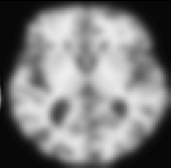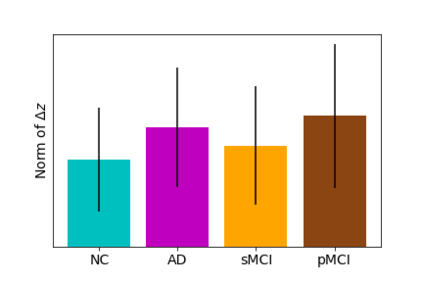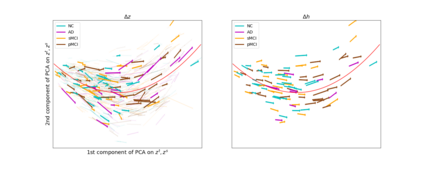Longitudinal MRIs are often used to capture the gradual deterioration of brain structure and function caused by aging or neurological diseases. Analyzing this data via machine learning generally requires a large number of ground-truth labels, which are often missing or expensive to obtain. Reducing the need for labels, we propose a self-supervised strategy for representation learning named Longitudinal Neighborhood Embedding (LNE). Motivated by concepts in contrastive learning, LNE explicitly models the similarity between trajectory vectors across different subjects. We do so by building a graph in each training iteration defining neighborhoods in the latent space so that the progression direction of a subject follows the direction of its neighbors. This results in a smooth trajectory field that captures the global morphological change of the brain while maintaining the local continuity. We apply LNE to longitudinal T1w MRIs of two neuroimaging studies: a dataset composed of 274 healthy subjects, and Alzheimer's Disease Neuroimaging Initiative (ADNI, $N=632$). The visualization of the smooth trajectory vector field and superior performance on downstream tasks demonstrate the strength of the proposed method over existing self-supervised methods in extracting information associated with normal aging and in revealing the impact of neurodegenerative disorders. The code is available at \url{https://github.com/ouyangjiahong/longitudinal-neighbourhood-embedding.git}.
翻译:通过机器学习分析这些数据,通常需要大量的地面真实标签,这些标签往往缺失或难以获取。减少标签需求,我们提出一个自我监督的代言学习战略,名为“纵向邻里嵌入”(LNE),受对比学习概念的驱动,LNE明确模拟不同科目的轨迹矢量的相似性。我们这样做的方法是在每次培训迭代中绘制一个图表,确定潜在空间的邻里,以使一个对象的前进方向遵循其邻里的方向。这导致一个平稳的轨迹场,在保持地方连续性的同时捕捉大脑的全球形态变化。我们将LNE应用于两个神经成形研究的纵向T1w MINIs:由274个健康科目组成的数据集,以及阿尔茨海默氏神经成像倡议(ADNI, $N=632美元)。在下游任务中,平稳的轨迹矢量场和超高性性性能展示了正常的内心机能。在正常的内压方法上展示了现有的自我意识。












